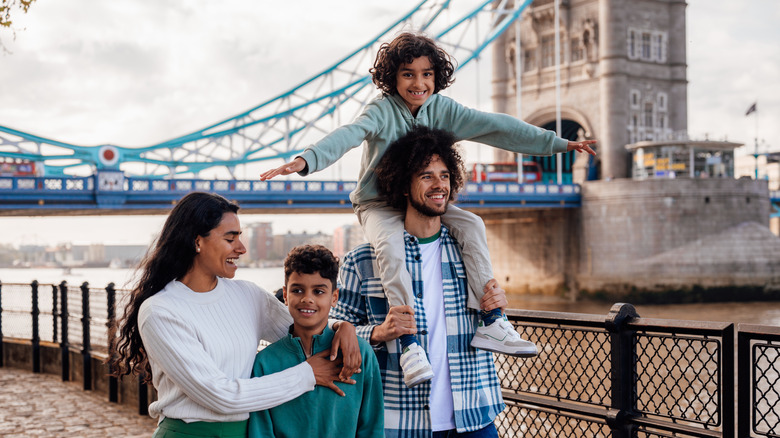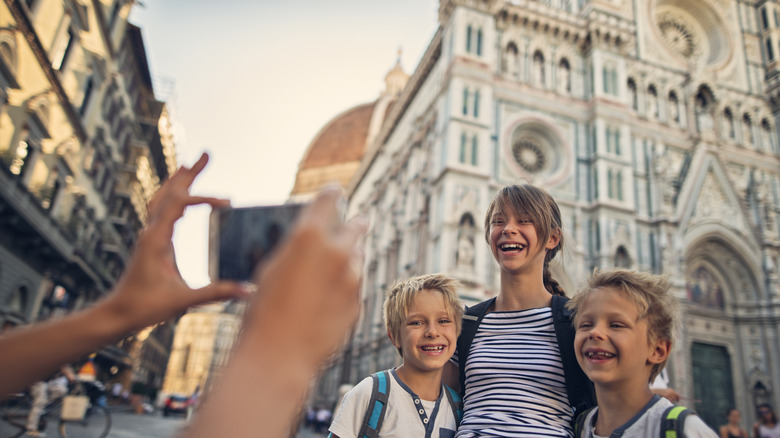Rick Steves Says This Is The Secret For A Successful Trip To Europe With Kids
Traveling with kids can be a wonderful and fulfilling experience. You get to spend some quality time together, have plenty of opportunities for teaching history, and see some amazing landmarks. Of course, there can also be exhausted crying after hours of walking, antics that happen out of boredom while standing in yet another line, and likely some moments of hunger-related tantrums. That can be especially true when it's combined with jet lag from a long flight from America to a European destination. Travel expert Rick Steves has tips that can rescue you from the rougher parts of traveling to Europe with kids in tow. Sure, there are a lot of pitfalls, but Steves has some great ways to avoid them.
It all starts at the planning stage, Steves explains. Involving them before you even begin to pack for a trip is important. (Use this packing hack for an easier time going through TSA as a family.) If you're going to, say, Paris, he suggests getting them excited for it by watching the Pixar film "Ratatouille" or preparing for a trip to Scandinavia with a viewing of "Frozen." It can give you some early ideas about what they might be most interested in. Books on landmarks — especially ones with kids in them — can help things feel more recognizable and comfortable when you get there. Here are some more tips on taking kids to Europe from Rick Steves and a few more from us at Islands.com.
Preparation lays the groundwork for a good time
Books and films aren't the only way to prepare. If you're going to England, watch a documentary about Queen Elizabeth I and Anne Boleyn and their experiences at the Tower of London. Give kids Roman helmets and plastic gladiator swords to play with before you visit the Colosseum. The show "Rick Steves' Europe" can be a great introduction to these places as well.
Steves also recommends keeping your expectations low. You may want to show your little ones all of Rome, but remember that little legs get tired faster and attention spans are shorter. Pick a couple of activities and really spend time there so the kids don't get worn out too early. We recommend bringing some familiar non-liquid snacks from home (to comply with TSA liquid rules) in case the kiddos get antsy in line. Steves says that adding in extended breaks is a good idea, as well. Don't rush meal times or push them off for too long, either. If all else fails, try this iconic chain restaurant in Europe.
Steves is a proponent of teaching kids a few words in the local language. Words like "hello," "goodbye," "thank you," and "please" are good ones. It makes kids feel like they're part of the culture rather than separate from it. We suggest learning the alphabet song together in another language and making an "in-line waiting game" of listening for words they know and spelling out signs in the foreign alphabet. They can also learn to use a language translator device or learn words on the free Duolingo app.
Other ideas for European travel with kids
Steves suggests looking for places with other kids, like town squares or playgrounds. Children do have a tendency to make friends quickly, and language isn't always a barrier to that. It will give them an opportunity to use their new skills with someone their own age. You can also teach them about foods they may encounter. Get a simple recipe online for a local dish and make it together before you go. Then order it and talk about how it's the same and how it's different. Another idea is a list of fun facts about a place, time, or building. Teach them about what flying buttresses are, for example, and make a game of who can find the most during the day.
Remember that these little brains are taking in a lot of info and may need time to process. Even breaks like a swim in a hotel pool or a few minutes to grab some gelato can help. If they're getting a little homesick, try creating a story together about what you saw that day that they can tell to a friend, sibling, or favorite stuffy when they get back.
Steves reminds us that it's a good idea to have the kids journal each day about their adventures. They don't have to write a book, though! They can find postcards to buy during the day or tell you a story about a place while you write it down. Add in drawings of the things you saw or people you met so the memories will last forever.


